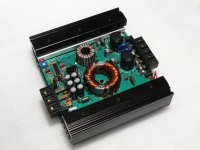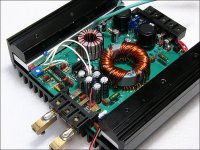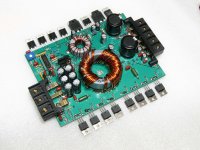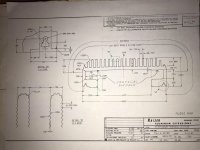I have a number of heatsinks that we hoped to use for a business we owned (small amp manufacturer). This was before the Chinese flooded the market. They are in the way in storage. I'm looking for a rough value (what people would pay for them). If the value is too low on the DIY market, we'll likely let them go for scrap value. We have them in 6, 8.5 and 11 inch lengths. For size reference, the boards in this example are 4.4" x 6".
The semiconductors are intended to be clamped to the heatsink by 3/8" x 1" aluminum stock and 10-32 setscrews. The board photo shows how the transistor layout is designed to be.
The semiconductors are intended to be clamped to the heatsink by 3/8" x 1" aluminum stock and 10-32 setscrews. The board photo shows how the transistor layout is designed to be.
Attachments
What a shame, they look like really well made amplifiers, better than a lot of the Chinese s**t. In answer to your question those heatsinks are a decent size and must be worth $20 or more, I'm no expert though, they'd cost a lot more than that obviously new, try em at $20 which I'm sure is a hell of a lot more than scrap value. Aluminium last time I weighed some in wasn't worth the bother, got a tenner for a big sack full.
While your at it try selling any amp modules you have too, they do look very nice, good luck, Andy.
While your at it try selling any amp modules you have too, they do look very nice, good luck, Andy.
Thanks for replying. You have to realize that all of the time boxing, labeling, getting them to the shipper has to be taken into account. Scrap is nothing more than calling someone to pick them up. From the other replies, here, there doesn't appear to be much demand.
The boards in the photos are universal power supplies that I thought might be interesting to DIY but they've been on my site for a couple of years and I don't think one person ever built one. The amp boards were of similar quality.
Thanks again.
The boards in the photos are universal power supplies that I thought might be interesting to DIY but they've been on my site for a couple of years and I don't think one person ever built one. The amp boards were of similar quality.
Thanks again.
There is always a huge market for HUGE heatsinks to satisfy those of us that like to build Class A amplifiers.
Unfortunately these are a bit too small for that.
These are a bit niche and there are plenty of medium sized heatsinks available.
Unfortunately these are a bit too small for that.
These are a bit niche and there are plenty of medium sized heatsinks available.
I know, it can take hours. Put them on here 5 at a go, seems a shame to scrap em.You have to realize that all of the time boxing, labeling, getting them to the shipper has to be taken into account.
Andy.
#4:
They would be available up to 11" long. They have a significant amount of surface area. The design was to allow very easy configuration/placement of the semis without drilling new holes.
#5:
We haven't made any decisions, yet. We're looking for input.
They would be available up to 11" long. They have a significant amount of surface area. The design was to allow very easy configuration/placement of the semis without drilling new holes.
#5:
We haven't made any decisions, yet. We're looking for input.
I have been buying used car hifi amps to use as a case/heatsink for class D modules to mount right on the back of a speaker or for some homegrown class AB amps, so I think there could be use for heatsinks like yours.
On the other hand, I found that in many cases ready made modules are too high to use inside the heat sink of a car amp. This might be an issue with your heatsinks, too.
As an aside, are there any fancy features to the DC/DC converter of your sample board?
On the other hand, I found that in many cases ready made modules are too high to use inside the heat sink of a car amp. This might be an issue with your heatsinks, too.
As an aside, are there any fancy features to the DC/DC converter of your sample board?
Nothing fancy but it had a lot of features. The following link is to the features section. It's a long page so you may have to reload if it doesn't land in the right place on the page. The graphics, for the most part, are no longer visible to those using win 10 unless you install ruffle.
Basic Switching Power Supply Design Tutorial
Basic Switching Power Supply Design Tutorial
As I said, they'd be neat to house modules if their height is sufficient. An UcD400 OEM is 38 mm high, just to give an example.
Great tutorial. I am no electronics design noob but I didn't find the TL494 data sheet very accessible, so your tutorial might help me with a few questions I had. I installed ruffle for Chrome, but it still won't display the pics. Will probably have to fire up an older computer I keep for unruly soundcards.
BTW, maybe you have an idea about my question here?
https://www.diyaudio.com/forums/car-audio/366196-rod-elliot-regulating-hard-mosfets.html#post6490395
Great tutorial. I am no electronics design noob but I didn't find the TL494 data sheet very accessible, so your tutorial might help me with a few questions I had. I installed ruffle for Chrome, but it still won't display the pics. Will probably have to fire up an older computer I keep for unruly soundcards.
BTW, maybe you have an idea about my question here?
https://www.diyaudio.com/forums/car-audio/366196-rod-elliot-regulating-hard-mosfets.html#post6490395
I tried ruffle for chrome but it was VERY slow. It worked better for opera (same engine as chrome). Sometimes the graphics show and sometimes you have a white area with an arrow that you have to click. If you find an older computer, use Safari 5.1.7 from Majorgeeks.
It's a shame that they decided to scrap Flash. They didn't just stop supporting it, They completely block its use. I've never seen that before.
I saw the question. I'll post there.
It's a shame that they decided to scrap Flash. They didn't just stop supporting it, They completely block its use. I've never seen that before.
I saw the question. I'll post there.
Thanks for replying. Flash player was an ongoing security nightmare which never had all its holes plugged and new exploits kept turning up, so I suppose they figured if new holes are not getting plugged, better block it. For pics/stills, there is not reason to use Flash anyway, you could replace them with about any image file format. Same for plain old videos. Animations must be harder to replace. The easiest way to preserve something that only contains still might be to convert it to pdf once it is displayed properly.
The Flash graphics were vector and could be scaled to any monitor resolution with no loss of resolution. When I started using it, the common resolution was 800x600. If I would have used a non-vector format, I would have had to redo the graphics every time the resolution got better. I still don't know anything better for interactive demos and calculators like the ones on my site.
Some PDF files are infinitely scalable but not all. When I was building web pages, you couldn't embed PDF files into the pages.
Some PDF files are infinitely scalable but not all. When I was building web pages, you couldn't embed PDF files into the pages.
Can you show the backside where the fins are? I think the area is quite large considering this. At first I thought it was only on the edges. This can be very useful for smaller Class AB chip amps as is, or for Class A paired with a Noctua fan.
Typical surplus CPU coolers of this size sell for $20 a pair. So I think that’s the value about $10ea for the 6in size shown. At 11in maybe $20ea. Try selling them on eBay if you have a lot. Or here if just a few. But some dimensional drawings, more photos of the back and the profile cross section, and a deg C/W per 6in or some other figure to estimate heat transfer would be good. You might have interest here with more data
Typical surplus CPU coolers of this size sell for $20 a pair. So I think that’s the value about $10ea for the 6in size shown. At 11in maybe $20ea. Try selling them on eBay if you have a lot. Or here if just a few. But some dimensional drawings, more photos of the back and the profile cross section, and a deg C/W per 6in or some other figure to estimate heat transfer would be good. You might have interest here with more data
Last edited:
Wait until hamfests resume and then go and see if you can sell some there at an outdoor table. Heat sinks are always being used for RF amplifiers, and yours look perfect for that purpose.
I'm having to rely on someone that has access to them. They are cut. The best I might be able to do is give the quantity of each size (6", 8.5" and 11").



